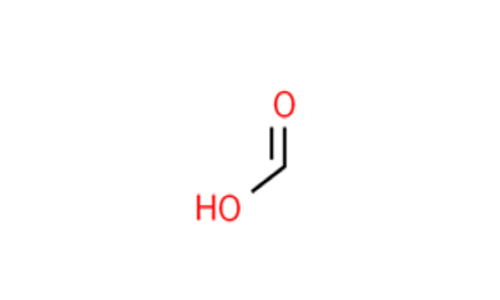Formic Acid, also known as methanoic acid, is a simple yet highly versatile organic acid with the chemical formula H−C(=O)−O−H. Naturally occurring in the venom of ants and in stinging nettles, Formic Acid is one of the simplest carboxylic acids and is widely used across various industries. Its primary applications are in agriculture, where it acts as a preservative and antibacterial agent in livestock feed. With its powerful antibacterial and preservative properties, Formic Acid is a valuable chemical in fields ranging from industrial to pharmaceutical applications.

| CAS Number: | 64-18-6 |
| UN Number: | 3412 |
| Hazard Class: | 8 |
| Packing Group: | II |
What is the CAS Number of Formic Acid?
The CAS number of Formic Acid is 64-18-6.
What is the UN Number of Formic Acid?
The UN number of Formic Acid is 3412.
What is the Hazard Class of Formic Acid?
Formic Acid falls under the transport Hazard Class 8.
What is the Packing Group of Formic Acid?
Formic Acid is classified under Packing Group II.
Physical properties of FORMIC ACID
Safety Information for Formic Acid 85%
Explore the safety details for Formic Acid 85% in our Material Safety Data Sheet (MSDS) below. This guide covers important hazard information, first aid steps, spill control, fire response, safe handling and storage, protective equipment, and more.
Before handling, please familiarise yourself with the potential risks associated with Formic Acid.
FAQs
Formic Acid 85% is widely used across various industries due to its strong acidic and preservative properties. In agriculture, it’s a popular additive in animal feed to prevent microbial growth, and it’s also used in silage preservation. The leather industry relies on Formic Acid for tanning and dyeing processes, while the textile sector uses it in dyeing and finishing fabrics.
Additionally, Formic Acid is a key ingredient in cleaning products, particularly for descaling, as well as in the production of rubber and certain pharmaceuticals due to its ability to act as a reducing agent and preservative.
The price of Formic Acid varies based on factors such as order quantity and shipping location. East Harbour Group offers tailored quotes to simplify your purchasing and delivery experience. Reach out to our team for a quote.
Yes, East Harbour Group offers global shipping for Formic Acid. Our expertise ensures smooth and efficient delivery to destinations worldwide, including Europe and Asia.
Health Hazards
Formic Acid 85% is harmful if swallowed, toxic if inhaled, and can cause severe skin burns and eye damage. It is essential to avoid direct contact and inhalation to prevent serious health risks.
Flammability
While not highly flammable, Formic Acid 85% can generate toxic flue gases, including carbon monoxide, in the event of a fire. Suitable extinguishing media include powder, foam, carbon dioxide, or water mist, but direct water streams should be avoided as they may spread the fire.
Handling and Safety Precautions
Ensure access to safety equipment, such as a safety shower, running water, and eye wash stations, when handling Formic Acid 85%. Always wash hands before breaks and at the end of work. Use effective ventilation, such as local exhaust systems, to minimise exposure and handle safely.
IF YOU WANT TO LEARN MORE ABOUT HOW EAST HARBOUR GROUP LTD CAN HELP YOUR BUSINESS, GET IN TOUCH.
